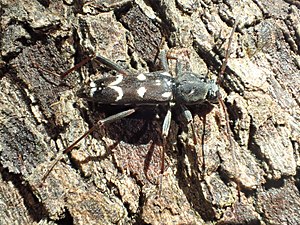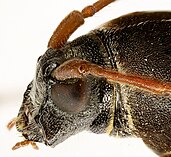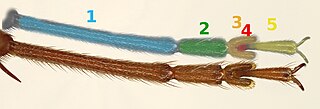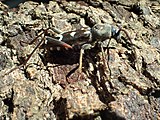Isotomus speciosus
| Isotomus speciosus | ||||||||||||
|---|---|---|---|---|---|---|---|---|---|---|---|---|

Isotomus speciosus on pine bark |
||||||||||||
| Systematics | ||||||||||||
|
||||||||||||
| Scientific name | ||||||||||||
| Isotomus speciosus | ||||||||||||
| ( Schneider , 1787) |
Isotomus speciosus is a beetle from the family of longhorn beetles (Cerambycidae) and the subfamily of Cerambycinae . The genus Isotomus isrepresentedby four species in Europe. The beetle, which was previously classified as rare, occurs in south-east Europe and south-central Europe. According to Appendix 1 of the Federal Species Protection Ordinance and the Federal Nature Conservation Act , the species is specially protected. Thebeetle may have become extinct in Poland , it is listed as endangered in Turkey , andthe first discovery in over 80 years has been reportedfrom Slovenia .
Note on names and synonyms
Schneider 1787 is considered the author of the kind. Schneider does not provide the first description. The beetle was first published by the theologian Schäffer in 1779 as part of a three-volume work in which Schäffer depicts all types of his collection (Fig. 1). The beetle is not described in a scientific sense, but only as the fourteenth (14th) after wood beetle (Leptura), with spherical breast shields . As a reaction to Schäffer's drawings, Harrer described the species depicted by Schäffer in 1784 , our beetle under the name Leptura figurata . Separately from this, Schneider produced a Nomenclator entomologicus in which he put together the names of the species depicted by Schäffer that these species had in Linnaeus , Fabricius and in other coleopterological works. This noun clator was published in 1785. In 1787, Schneider stated in a commentary on Harrer that the beetle named after Harrer Leptura figurata cannot keep this name because this name has already been assigned to another beetle. Schneider therefore gave the beetle the species name speciosum , which it already had in 1785 in Schneider's nomenclator entomologicus . In this nomenclature, the beetle is classified under the species that Fabricius classifies as part of the genus Callidium he created , and that of Linnaeus to the genus Leptura . The species name speciosus is bracketed in the nomenclator, provided with an * and supplemented with the abbreviation nd . According to Schneider's own statements, the brackets mean that the species can be found in Europe, the asterisk * indicates that the species is in Schneider's collection and nd says that the beetle is being used by entomologists in the area for the time being (ad interim) so called, so a description has not yet been published.
The genus Isotomus was introduced by Mulsant in 1862 as a subgenus of the genus Clytus . The name derives from altgr. ίσος (ísos) for equal and τομή (tomé) for section and alludes to the fact that the ninth antenna segment is as long as the fourth.
The species name speciosus ( Latin for magnificent, valuable ) expresses that the relatively large beetle is rare, beautifully drawn and therefore sought after by collectors.
In 1798 Fabricius described our beetle under the name Callidium semipunctatum , which he called Clytus semipunctatus in 1801 . This name was used by some older authors to describe it, although they knew the name given by Schneider.
The species Callidium speciosum Adams (now Plagionotus Neoplagionotus bobelayei ) has nothing to do with the beetle Callidium speciosum Schneider (now Isotomus speciosus ) discussed here .
Properties of the beetle
The beetle is twelve to twenty-two millimeters tall and has a very slim build. The basic color is black (Fig. 2) or dark brown (Fig. 9) with fine dark hair. The markings are created by white or light yellow hairy spots. If the hair on the top is lighter, the drawing can become indistinct. The antennae and legs are mostly red-brown, the thighs at the tip are often darkened.
The head is carried down about 50 degrees to the body axis (Fig. 3 right). It is slightly thickened behind the kidney-shaped eyes , not pinched off like a neck. It is narrower than the pronotum . A narrow longitudinal groove is formed on the sparse, downy, hairy forehead, which continues down to the vertex (Fig. 3). The end links of the four-part jaw probe (Fig. 3, bottom left) and the three-part lip probe are trimmed. The eleven-part antennae are thin and longer than half the body. They are much closer together on the forehead than the inner edges of the eyes (Fig. 3 left). The middle sections of the antennae are square (arrowhead in Fig. 5). The third antenna segment is more than three times as long as the second, the first segments have a fringe of long eyelash hairs (Fig. 5). The name- giving property of the genus Isotomus is that the ninth antenna link is the same length as the fourth link, not shorter than this. Fig. 5 shows that this does not exactly apply to the photographed specimen of Isotomus speciosus . Appropriate images of the species on the Internet (for example here) also show, when enlarged, that the ninth link of Isotomus speciosus is barely as long as the fourth.
The pronotum is hardly narrower than the elytra and a little longer than wide. All corners are strongly rounded. The pronotum is cut off almost straight at the front and back. The pronotum bears a line-shaped white spot in the back of the midline and a little in front and to the side of it a small spot, which lies in a very shallow depression. The front edge of the pronotum is also provided with an indistinct white hairline. Visible only from the side, there is also a spot above the front hips, usually larger than the spots on the top of the breast shield. The puncture of the pronotum is dense and clear, noticeably denser than the puncture of the head (clearly visible in Fig. 3 on the right when fully enlarged). At the base of the pronotum, the puncture becomes more diffuse.
The small, rounded label is hairy white.
The elytra are almost three times as long as together wide. At the end they are truncated at an angle, the outer angle is angular (Fig. 7). The wing covers leave the tip of the abdomen uncovered (Figs. 7 and 8). Viewed from above, the drawing of each wing cover typically consists of five elements:
- in the shoulder pit there is a medium-sized elongated spot
- a little behind, near the wing cover seam, a rather small elongated spot,
- after the first third there is a large, transversely lying spot, which can also be interpreted as an incomplete bandage
- approximately in the middle between this and the wing top tip runs a sickle-shaped transverse band, which is strongly bulged forward; the ligaments of the two wing covers touch at the seam and run a short distance backwards together; outwards they do not reach the side edges of the wing cover
- finally the tip of the wing cover is still white.
At about the same level as the second spot, there is another spot near the side edge, which can be very small. But this is only visible from the side, not from above. The puncture of the elytra is even more dense than that of the pronotum, but it is very flat and difficult to see.
The legs , especially the splints, are long and thin, the thighs slightly thickened in a club-shaped manner. The front hips are spherical (tinted yellow in Fig. 8 on the lower half of the picture), not cylindrical transversely and not protruding downward in the shape of a cone. The tarsi are apparently four-limbed (the small fourth limb sits in the section of the third limb, Fig. 5 above in red). The first limb of the middle tarsi is longer than the rest of the limbs combined, minus the claws (Fig. 6). However, this cannot be seen from above, as the splint then covers part of the first tarsi segment (this is why the tarsi in Fig. 6 are photographed from below). The first segment of the hind tarsi (Fig. 4 blue) is significantly longer than the second and third combined.
On the underside (Fig. 8) there is also a white mark, in particular the rear edges of the posterior sternite are white.
biology
The species loves warmth. It is twilight-active and likes to hide in dead wood during the day, but is also found on blossoms and felled trunks. On warm evenings, the beetle can be seen walking around the trunks very quickly at the edges of the forest during the mating season.
The beetle develops polyphagous in dead branches of various hardwoods ( oak , beech , elm , sweet chestnut , apple , maple , hornbeam , hazel ). Pupation takes place at the end of May after a larval development of presumably more than two years. The adult beetles can be found on the breeding trees from June to August. In Turkey, adult beetles have also been found on the Caucasus spruce .
distribution
The species is native to south-east Europe and south-central Europe, to the east the range extends to southern Russia, the Caucasus and Transcaucasia . There are some old finds from southern Germany, but the species does not seem to have been native there. An old find in Barcelona can probably be traced back to imported furniture. Probably the same applies to Iceland, which is included in the range of the Fauna Europaea. Apart from these three exceptions, the western border of the distribution area runs through Italy , Austria , the Czech Republic and Poland. It is likely to occur in Switzerland.
literature
- Edmund Reitter : Fauna Germanica, the beetles of the German Empire IV. Volume, KGLutz 'Verlag, Stuttgart 1912, p. 52 as Clytanthus (Caloclytus) speciosus
- Heinz joy, Karl Wilhelm Harde, Gustav Adolf Lohse (ed.): The beetles of Central Europe . tape 9 . Cerambycidae Chrysomelidae . Spektrum Akademischer Verlag, Munich 1999, ISBN 3-8274-0683-8 (first edition: Goecke & Evers, Krefeld 1966). P. 68
- Klaus Koch : The Beetles of Central Europe . Ed .: Heinz Freude . tape 3 : ecology . Goecke & Evers, Krefeld 1992, ISBN 3-87263-042-3 . P. 37
- Adolf Horion : Faunistics of the Central European Beetles Volume XII: Cerambycidae - Longhorn Beetles, Überlingen - Bodensee 1974 p. 144
- Gustav Jäger (Ed.): CG Calwer's Käferbuch. K. Thienemanns, Stuttgart 1876, 3rd edition, p. 522 as Clytus semipunctatus
Individual evidence
- ↑ a b c Isotomus speciosus from Fauna Europaea, accessed on October 8, 2018
- ^ Database Wisia online page for query
- ↑ Zbigniew Głowaciński: Red list of threatened animals in Poland, Supplement ISBN 83-88934-21-X under Invertebrata, EX, EX?
- ↑ Hüseyin Özdikmen: Turkish Red List Categories of Longicorn beetles (COLEOPTERA: CERAMBYCIDAE) - Part VIII - Subfamily Cerambycinae: Anaglyptini and Clytini p. 692
- ↑ Al Vrezec: POJAVLJANJE KOZLIČKA ISOTOMUS SPECIOSUS (SCHNEIDER, 1787) V SLOVENIJI (COLEOPTERA: CERAMBYCIDAE) in Slovenian Entomological Society Vol. 12, št. 2: 249-252, LJUBLJANA, DECEMBER 2004 Find in Slovenia
- ↑ a b Jakob Christian Schaeffer: Icones Insectorum circa Ratisbonam indigenorum ... Regensburg 1779 Figure Fig. 7 and Fig. VII, description as 14th Leptura , without species name
- ↑ Georg Albrecht Harrer: Description of those insects that Mr. D. Jacob Christoph Schäffer published in 280 painted copper plates under the title Icones Insectorum circa Ratisbonam Indigenorum in three parts Regensburg 1784 p. 213, No. 351 Description as Leptura figurata
- ↑ a b David Heinrich Schneider: Nomenclator entomologicus or systemaitsches list of names of the so far known insects Leipzig 1785 p. 16 4th column speciosum and explanation of the signs
- ↑ David Heinrich Schneider: Some corrections and additions to the allegates listed from Schäffer's Icones Insectorum Ratisbonesium in Fabriciis Species Insectorum compared with Harrer's description of the Schäffer depicted insects in New Magazine for Entomology Lovers Volume 3, second piece, Zurich 1787 p. 137: 125
- ^ A b E. Mulsant, Histoire naturelle des coléoptères de France Volume 2, Longicornes, Paris 1862–1863 subgenus Isotomus and Clytus semipunctatus p. 183
- ↑ Sigmund Schenkling: Explanation of the scientific beetle names (genus)
- ↑ Sigmund Schenkling: Explanation of the scientific beetle names (species)
- ^ Joh. Chr. Fabricius: Entomologiae systematicae, emmendatae et auctae, Supplementum Hafnia (Copenhagen) 1798, p. 151 Callidium semipunctatum
- ^ Joh. Chr. Fabricius: Systema Eleutheratorum Volume 1. Kiel 1801 p. 346, No. 5 in the Google book search
- ↑ Maxim A. Lazarev: Several taxonomical remarks on Palaearctic Cerambycidae (Coleoptera) with two new names and two new taxa in Humanity space International amanac Vol. 5, Supplement 2, 2016: 12-17 [1]
- ↑ Figure on a coleopterological Polish page on the left male, right female
- ↑ Delaporte de Castelnau, H. Gory: Monographie du genre Clytus presented by Geoffroy-Saint-Hilaire and Duméril at the meeting of the Académie Royale des Sciences on January 4, 1836, published in Histoire Naturelle et Iconographie des insectes coléoptères Volume 3, Paris 1841 as Clytus semipunctatus p. 75
- ^ Coleo-net, Key of the Cerambycinae and Key of the Cerambycidae
- ^ Ludwig Redtenbacher: Fauna austriaca - Die Käfer second edition, Vienna 1858 as Clytus semipunctatus p. 853
- ↑ HC Küster: The beetles of Europe - described from nature, 15th booklet, Nuremberg 1848 as Clytus semipunctatus without page number
- ^ Friedrich F. Tippmann: Studies on Plagionotus detritus L. and arcuatus L. in communications from the Munich Entomological Society, Volume 41, year 1951, p. 137 footnote
- ↑ Petr Švácha, Mikhail L. Danilevsky: Cerambycoid Larvae of Europe and Soviet Union (Coleoptera, Cerambycoidea) Part 2, Acta Universitatis Carolinae, Biologica vol. 31, pp. 121-243 Univerzita Karlova, Praha 1988
- ^ Hazan Alkan, Mahmut Eroglu: A Contribution to the knowledge of Cerymbycidae (Insecta: Coleoptera) species in the Eastern Black Sea Region in Turkey in Türk. entomol. the G. 2001, 25 (4): 243-255 ISSN 1010-6960 [2]
- ^ Eduard Vives: Notas sobre longicornios ibéricos (V). Cerambícidos importados o aclimatados en la Península Ibérica (Coleoptera, Cerymbycidae) in Zapateri, Rebista aragon. entomologica 5. 1995, pp. 165-174 ISSN 1131-933X p. 170
- ↑ Christian Monnerat, Yannick Chittaro, Andreas Sanchez, Yves Gonseth: List comentée des Lucanidae, Cetonidae, Buprestidae et Cerambycidae (Coleoptera) de Suisse in communications from the Swiss Entomological Society 2015, 88 173-228 p. 211










